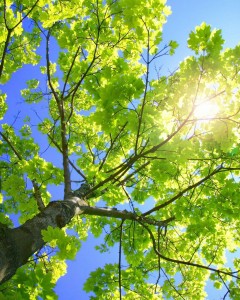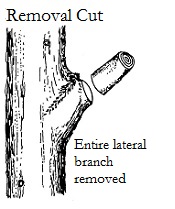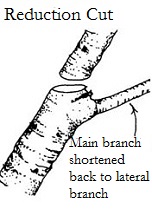Why do we trim trees? Well, I don’t have enough space to thoroughly beat this particular horse, but I will give you a few different answers. The American in me wants trees trimmed for liability and management reasons; keep the lawyers at bay. The South African in me thinks that trees should be mostly left alone but trimmed to stay out of people’s way, possibly by your pet giraffe. My English ancestry calls for aesthetic tree trimming; everything should look beautifully manicured.
Whatever the reason for trimming, the important thing is to understand your objective for the trees…
…and make sure all parties involved are aware of it. Only then can we have functional and not merely arbitrary tree trimming. Trim for safety or clearance or a certain aesthetic or even size, but know why you are trimming!
 Now that we’ve figured out why, now let’s work on how. Do you want to crown clean or crown thin or lace or shape
Now that we’ve figured out why, now let’s work on how. Do you want to crown clean or crown thin or lace or shape
or balance or structure prune or crown reduce or restructure or restore or clearance prune? I have no idea either. Let’s start by picking terminology that matches the objective. If your objective is safety, then crown cleaning and weight reduction are a good start. If personal space is needed, clearance pruning should suffice. If your trees are too large, crown reduction will be the answer. If you are looking for the manicured look, crown thinning and light crown reduction are the way to go.
Unless you actually own a chainsaw and a pole-pruner, the previous paragraph might not make much sense so let’s simplify things. For different objectives and different overall costs, different parts of the tree should be pruned to varying degrees. If a tree is in your way, prune the bottom or sides. If a tree is dangerous, trim the top and sides, or remove it completely and start again. If a tree is blocking your view or creating too much shade, trim the top or replace the tree with a bush. If you are trimming for aesthetics, then a little pruning all over might be needed.
At least one person has bothered to read this far and might now be asking: “What about trimming to benefit the health and structure of the tree?” Thank you for the great question. In an ideal world, we would be pruning young trees to encourage structural integrity – usually seen as a strong central leader with appropriately sized, well-attached lateral branches. We call this structural pruning and we might only do a couple of cuts per tree. In mature trees, pruning for structural integrity means well-placed weight reduction cuts – making those overgrown branches a bit shorter and reducing their leverage.
Pruning for health is a little tricky. Trees make food for themselves in their leaves with a fancy combination of sunlight, carbon dioxide and chlorophyll. Surely, if someone dramatically reduces the number of leaves in a tree they would be reducing the amount of potential food being made. Will more leaves grow? Yes! The tree will use stored energy and promote the development of latent buds; then you can have the trees trimmed again. However, this energy drain will have a detrimental effect on the tree since it will leave it with lower energy reserves for combating harmful insects and diseases. So let’s quietly agree to prune for structural integrity and not to try to prune for health.
Now [I promise we’re almost done], how is this pruning going to be done? There are three types of cuts we can make: removal cuts, reduction cuts and heading cuts. That’s it! These three cuts will be used to meet any pruning objective we might have. Removal cuts remove an entire branch or clean out the center of a tree. Reduction cuts shorten a branch back to a lateral branch; the lateral branch then acts as the new dominant end of the branch and keeps hormonal control over unregulated growth. Our least favorite type of pruning is the heading cut. These are made to reduce the length of a limb but leave a stub instead of a lateral branch at the new end. These cuts are used in topping, rounding over and hedging, and will trigger uncontrolled new growth. We train our climbers that heading cuts are a poor method of tree trimming, but there are times when a heading cut is the only option available to meet your pruning objectives. Possibly all lateral branches were removed by the last tree trimmer, or you need to significantly reduce the tree. In these cases, crown restoration will be needed over the next few years to rebuild apical dominance and decrease the potential for future breakouts.
If you have a new tree trimming company each year (lowest-bidder, race-to-the-bottom), then it is possible that your objectives will not be met effectively. Your trees are potentially being harmed by arbitrary and unnecessary pruning. Pick a good tree trimming company, discuss your objectives, and create a nice long relationship that benefits your trees.
And as always, please remember to water your trees.
– Peter Green, Tree Health Care Manager
Illustration of various pruning cuts. Digital image. Landscape Plants; Pruning Cuts. University of Florida, n.d. Web. 6 May 2015.



